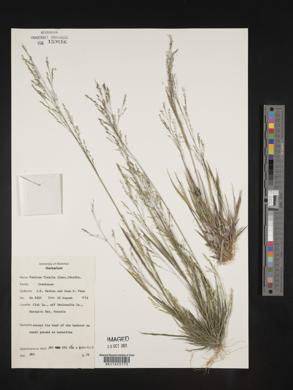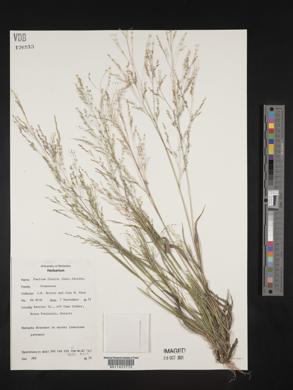Panicum flexile
|
|
|
|
Family: Poaceae
Wiry Panic Grass, more...Panic Flexible, wiry panicgrass, Wiry Witchgrass
|
Annual herb, tufted 10 cm - 0.75 m tall Leaves: alternate, two-ranked. Sheaths green or purplish, longer than internodes, and hairy. Ligules 0.5 - 1.5 mm long, membranous, sparsely fringed with hairs. Blades ascending to upright, 3 cm - 32 m long, 1 - 7 mm wide, linear with a tapering base and pointed tip, parallel-veined, sparsely hairy. Inflorescence: a branched arrangement of spikelets (panicle), open, 5 - 45 cm long, 1 - 6 cm wide, three times longer than wide, at least half as long as the plant, with ascending to slightly diverging primary branches and diverging secondary branches. Primary branches alternate or subopposite. Fruit: a caryopsis, indehiscent, enclosed within the persistent lemma and palea. Culm: unbranched or basally branched, 10 cm - 0.75 m long, about 1 mm wide, round in cross-section. Nodes densely soft-hairy with ascending hairs. Spikelets: 2.5 - 3.5 mm long, 0.5 - 1 mm wide, narrowly egg-shaped with a pointed apex. Glumes: unequal, herbaceous. Lower glumes about 1 mm long, one-third to one-half as long as spikelets, pointed at the apex. Upper glumes 2.5 - 3.5 mm long, exceeding upper florets by about 0.5 mm, seven- to nine-veined. Lemmas:: Lower lemmas similar to upper glumes, 2 - 2.5 mm long, exceeding upper florets by about 0.5 mm, pointed and minutely rough at the apex, seven- or nine-veined, keeled. Upper lemmas shiny, with rolled-up margins on the upper surface. Paleas:: Lower paleas absent. Upper paleas longitudinally lined. Florets:: Lower florets sterile. Upper florets bisexual, pale or sometimes dark at maturity, slightly over 1.5 mm long, about 0.5 mm wide, pointed at the apex. Anthers three. Stigmas red. Similar species: No information at this time. Flowering: July to October Habitat and ecology: Locally frequent in calcareous wet areas such as fens. It is also found on limestone in seepage places. Occurence in the Chicago region: native Etymology: Panicum comes from the Latin word panis, meaning bread, or panus, meaning "ear of millet." Flexile means flexible. Author: The Morton Arboretum Slender annual 2-6 dm, erect or nearly so, branched from the base; blades erect, 2-6 mm wide; peduncle exsert, often elongate, the panicle 6-20 cm, half to a third as thick, with numerous ascending or spreading capillary branches, the axillary pulvini glabrous; spikelets narrowly lanceolate, 2.6-3.6 mm; first glume usually acute, nearly half as long as the acuminate second glume and sterile lemma; fr stramineous, narrowly ellipsoid, 1.8-2 mm, a fourth to a third as wide; 2n=18. Moist or dry soil, often in open woods; N.Y. and s. Ont. to N.D., s. to Fla. and Tex. Gleason, Henry A. & Cronquist, Arthur J. 1991. Manual of vascular plants of northeastern United States and adjacent Canada. lxxv + 910 pp. ©The New York Botanical Garden. All rights reserved. Used by permission. From Flora of Indiana (1940) by Charles C. Deam Infrequent in the northern and southern counties. In the north it is found in dry or moist, sandy soil, usually on the marly borders of lakes, and on interdunal flats. In the southern counties it is found in poor, dry soil in open places on the crests of ridges, on washed or rocky slopes, and in dry pastures. …… Indiana Coefficient of Conservatism: C = 0 Wetland Indicator Status: FACW |














































































